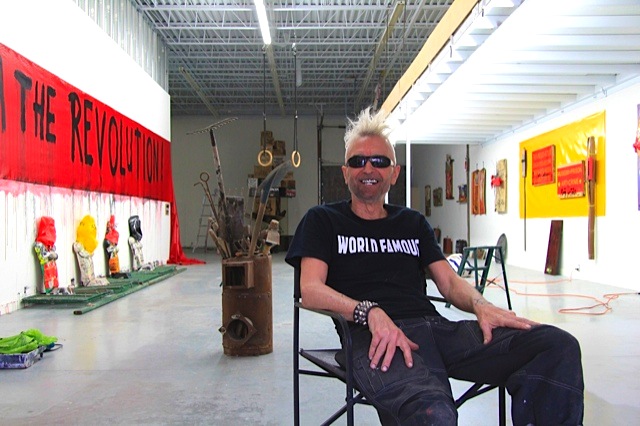 Istvan Kantor in his show, Etude to Asylum. Photo: Sandy Baron
Istvan Kantor in his show, Etude to Asylum. Photo: Sandy Baron
The favorite medium of the revolutionary art mastermind, Istvan Kantor, is blood. In his performances he often uses his own blood to create art, like at the Theatre Centre Pop Up on July 11, 2013 in Toronto. Kantor laid down a map of North America on the floor, directly under two hanging gymnastic hoops. Pulling himself up and putting his legs through the hoops, he injected a needle into his left arm. This produced blood that dropped onto the map as he hung upside down and created a drawing with his blood over the map. In August, 2014, he painted a blood-red “X” using his own blood behind Jeff Koons’s famous Rabbit sculpture at the Whitney Museum of American Art, through Koons’ retrospective exhibition. He was arrested on the spot by the New York Police and taken to a mental hospital for examination. In 2015 he dripped his blood into the Yellow River, the “Mother River” for Chinese people, in order to achieve a mixture “between his inner spirits and Chinese culture.”
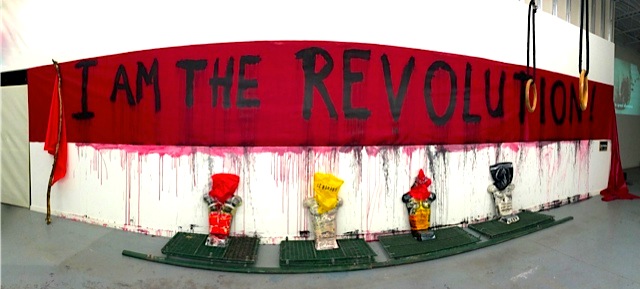 Installation view of Etude to Asylum. Photo: Sandy Baron
Installation view of Etude to Asylum. Photo: Sandy Baron
In his solo exhibition Etude to Asylumin in the Robert Kananaj Gallery, curated by Robert Kananaj, Kantor fills the space with a lot of red. One wall is covered with a huge red poster, “I AM THE REVOLUTION”” written on it. As Kantor said it “is pointing to the fact that indivisual power is the most important and should have more marks on society than corporate power. On the other hand it is also the cry of a lunatic-genius who imagines him/herself to be the king or the master of the universe.” It is always more than one possible interpretations of these works. In his installations red objects like clothes, paint and plastic toys are frequently used. On the exterior wall of the gallery there is a giant red cross scrawled by the artist himself several days before the opening. The big “graffiti” sign reveals the truth of our society: “EVERYTHING IS UNDER CONTROL!” All the red objects and paintings inside and outside of the gallery remind the viewers of blood and violence.
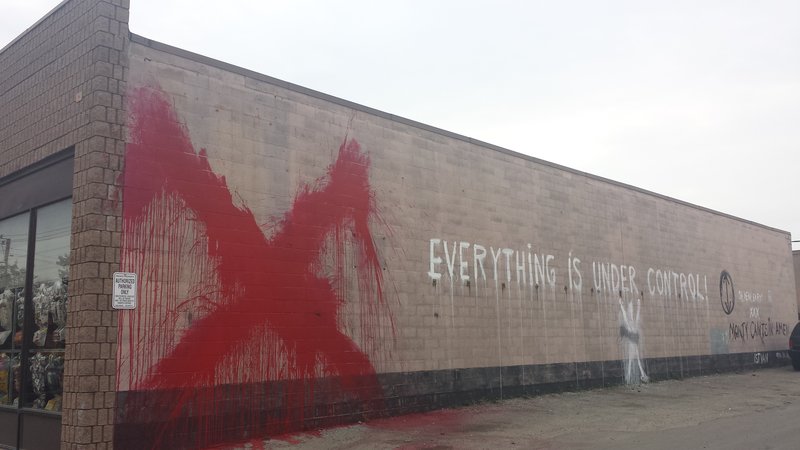 The outside wall of Robert Kananaj Gallery, painted by Istvan Kantor. Photo: Daisy Li Meng
The outside wall of Robert Kananaj Gallery, painted by Istvan Kantor. Photo: Daisy Li Meng
Kantor never hides his opinion. He has always expressed his strong, even extreme, disappointment with the commercial-oriented system of today’s art scene, the lack of government support for local artists as well as the uneven distribution of resources among art practitioners. He includes noises, strong colors and lights in his installations and sculptures in order to display the tension between money and art, dominance and subordination, illusion and reality.
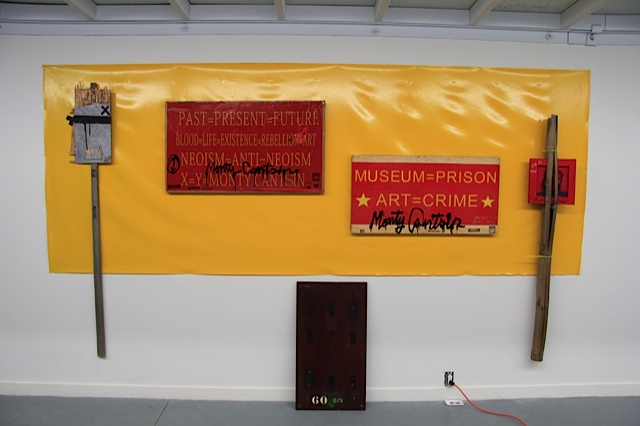 Installation view of Etude to Asylum. Photo: Sandy Baron
Installation view of Etude to Asylum. Photo: Sandy Baron
Deeply influenced by Joseph Beuys, the famous German theorist and performance artist, Kantor also believes that anyone could be an artist, and any material, no matter what it is, could be utilized by artists and displayed in art galleries. There are a large number of those objects in Robert Kananaj Gallery, such as a cart, paper boxes, two gymnastic hoops hanging in the middle of the space, as well as several plastic mannequins covered with archivival products made from original leftover flyers, notes, posters, cards the artist accumulated since the late 70s.
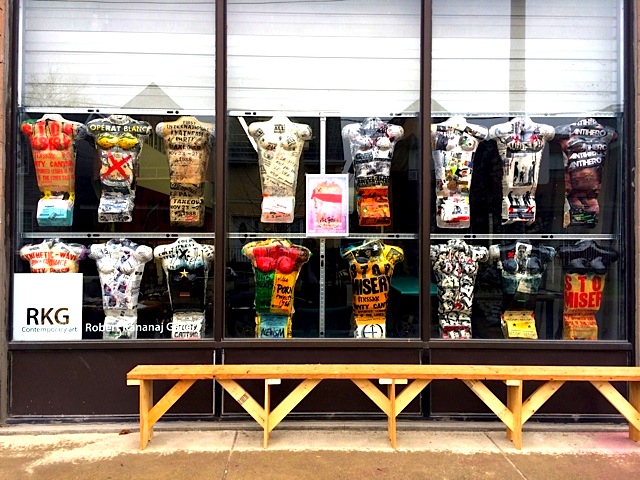 Installation view of Etude to Asylum. Photo: Sandy Baron
Installation view of Etude to Asylum. Photo: Sandy Baron
Kantor’s work reminds me of the art of Theaster Gates, an American artist and social activist. Both Gates and Kantor have a strong social sensitivity and prefer to use abandoned and discarded materials. Kantor uses stronger colors and his compositions are often collage-like. His messages scream from the walls – it is impossible to ignore them.
Most of the work displayed in the exhibition were actually created in 2015 here and in China. Kantor’s brotherhood with Ai Weiwei and the similarity in their lives is also important. Weiwei is considered a revolutionary artist in the West but only a troublemaker for the government in China. Kantor is banned here in Canada from the AGO and the National Gallery but are welcomed in many prestigeous European and Asian media-and performance art events and exhibitions.
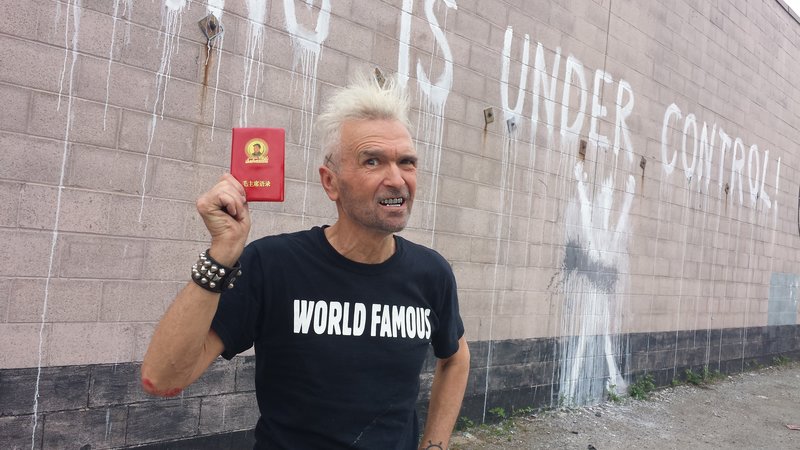 Istvan Kantor with the Red Book of Chairman Mao. Photo: Daisy Li Meng
Istvan Kantor with the Red Book of Chairman Mao. Photo: Daisy Li Meng
To some extent, the space of Robert Kananaj Gallery should seem like an asylum for Kantor but instead of escaping the political turmoil of the world, he brings it inside the gallery. He soldiers on with holding a shovel in his right hand and the Red Book of Chairman Mao in his left.
Daisy Li Meng
*Exhibition information: Etude to Asylum by Istvan Kantor, May 5 – June 6, 2015, Robert Kananaj Gallery, 172 St Helens Avenue Toronto. Gallery hours: Tue – Sat 11 – 6 p.m.
